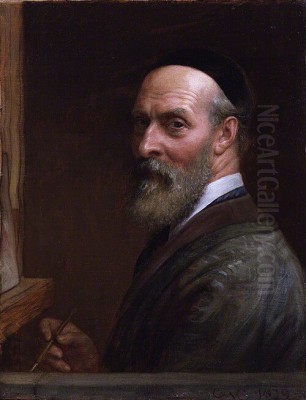
Charles West Cope stands as a significant figure in the landscape of British Victorian art. Born in Leeds in 1811 and passing away in Bournemouth in 1890, his life spanned a period of immense social and artistic change in Britain. The son of an artist himself, Cope received a formal art education that grounded him in tradition, yet his work consistently engaged with the contemporary values and historical consciousness of his time. He became particularly renowned for his sensitive portrayals of domestic life and his contributions to the grand historical narratives decorating the newly rebuilt Houses of Parliament, securing his place as a respected Royal Academician and a key painter of his generation.
Early Life and Artistic Formation
Charles West Cope's journey into the art world began under the influence of his father, also an artist. His formal training commenced at the prestigious Royal Academy Schools in London, an institution that shaped many of Britain's leading artistic talents. Seeking broader horizons and deeper engagement with the masters of the past, Cope travelled to Paris. There, and particularly through dedicated study in the galleries of the Louvre, he immersed himself in the works of the Old Masters.
His studies were wide-ranging, but he developed a particular affinity for the rich colours and compositions of the Venetian School, admiring figures like Titian. The dramatic intensity and psychological depth found in the works of Rembrandt also left a lasting impression on the young artist. This period of study abroad was crucial, equipping Cope with a strong technical foundation and a deep appreciation for the European artistic tradition, elements that would inform his own distinct style throughout his career. His first notable success came early, signalling his emerging talent.
Emergence and Early Recognition
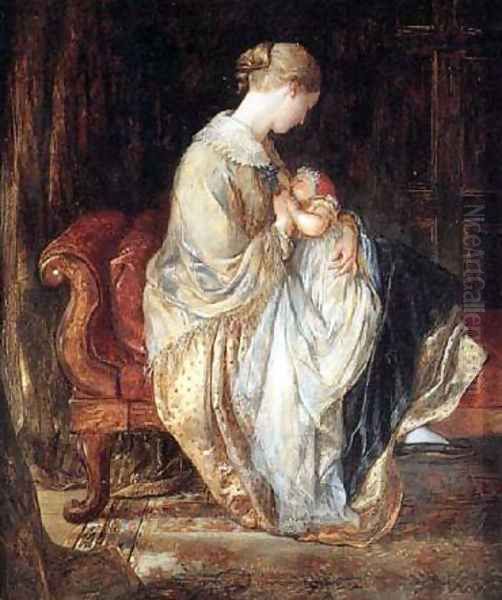
Cope made his public debut at the Royal Academy exhibition in 1831 with a painting titled The Holy Family. This work, rooted in traditional religious subject matter, demonstrated his technical proficiency and compositional skills learned through his studies. Its quality attracted the attention of a significant contemporary collector, William Beckford, known for his discerning taste and patronage of the arts. Beckford's purchase of The Holy Family provided Cope with valuable early recognition and encouragement.
This initial success helped launch Cope's career. He continued to exhibit regularly at the Royal Academy, gradually building his reputation. His early works often explored religious and historical themes, reflecting his academic training and his engagement with the grand traditions of European art. However, he soon began to diversify his subject matter, turning his attention towards the intimate scenes of everyday life that would become a hallmark of his oeuvre.
Master of Domestic Scenes
While adept at various genres, Charles West Cope truly excelled in the depiction of domesticity. He possessed a remarkable ability to capture the tender moments and quiet dramas of family life, resonating deeply with Victorian sensibilities that idealized the home and familial bonds. Motherhood was a recurring and central theme in his work, explored with sensitivity and warmth. Paintings like Young Mother (1845) and Mother and Child (1852) exemplify his focus on the maternal relationship, portraying it with gentle affection and quiet dignity.
One of his most beloved works in this vein is The First Piano Lesson. This charming painting depicts a mother holding her young child at a piano, the sheet music for a piece titled 'Palermo' visible on the stand. The scene encapsulates themes of education, maternal guidance, and the cultural importance of music within the Victorian middle-class home. It showcases Cope's skill in creating narrative through subtle gesture and carefully chosen details, rendered with his characteristic elegance and pleasing colour palette.
Cope also explored the emotional complexities of relationships within the domestic sphere. Works such as Palpitation and The Inquisition delve into the anxieties and tensions often present in courtship during the Victorian era, particularly highlighting the nervousness or emotional stirrings ('palpitation') experienced by young people, sometimes related to social conventions or age differences. These paintings reveal Cope's insightful observation of human emotion and his willingness to engage with the underlying psychological currents of his time, moving beyond simple sentimentality. The Thorn is another work often cited within his exploration of Victorian emotional landscapes.
Historical Painting and Public Commissions
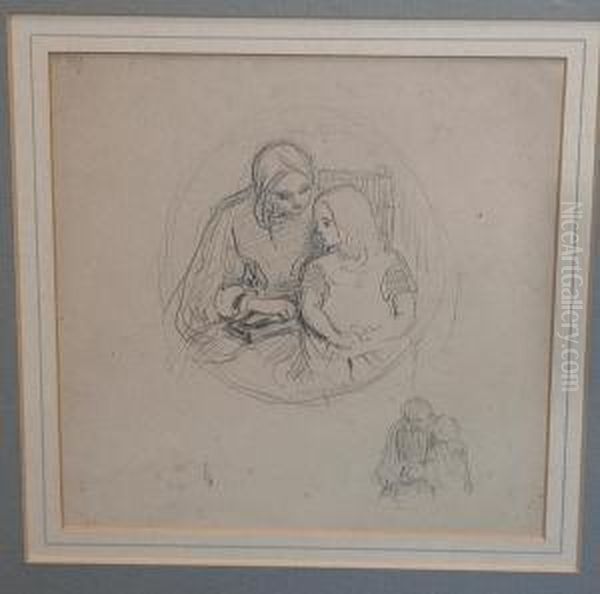
Beyond the intimacy of the domestic sphere, Cope also engaged with the grand narratives of British history. His interest in the past, particularly the tumultuous period of the English Civil War, found a significant outlet in one of the most prestigious public art projects of the era: the decoration of the newly rebuilt Houses of Parliament in Westminster, following the devastating fire of 1834. This project aimed to visually articulate Britain's history and values within the heart of its government.
Cope was among the artists selected for this major commission, tasked with creating large-scale frescoes for the corridors of the Palace of Westminster. His contributions focused on key moments from the 17th century. Notable examples include The Embarkation of the Pilgrim Fathers, The Burial of Charles I at Windsor, and Speaker Lenthall asserting the Privileges of the Commons against Charles I when the Attempt was made to seize the Five Members. These works required not only artistic skill but also historical research and the ability to compose complex, multi-figure scenes suitable for a monumental setting.
His success in this demanding field demonstrated his versatility. Earlier, in 1843, he had already shown an aptitude for historical and allegorical work by winning a prize from the Royal Academy commissioners for his cartoon (a full-scale preparatory drawing) titled Trial by Jury. Cope's history paintings contributed significantly to the visual culture of national identity being forged in the Victorian era and cemented his reputation as an artist capable of tackling subjects of major public importance. His work in Parliament placed him alongside other notable historical painters commissioned for the project, such as Daniel Maclise.
The Etching Club and Printmaking
Charles West Cope was not only a painter but also a dedicated printmaker, particularly skilled in the art of etching. He played a pivotal role in the Victorian Etching Revival, a movement that sought to elevate etching as a serious artistic medium beyond its purely reproductive function. To this end, Cope was a founder member of The Etching Club, established in the late 1830s. This group brought together artists interested in exploring the creative possibilities of the etched line.
The Etching Club included several prominent artists among its members, fostering a collaborative and experimental environment. Notable figures associated with the club included the Pre-Raphaelite painter William Holman Hunt and the visionary landscape artist Samuel Palmer. Other members or associates over time included artists like Richard Redgrave and Thomas Creswick. The club published collective volumes of etchings, illustrating literary works or presenting original compositions, thereby promoting the medium to a wider audience.
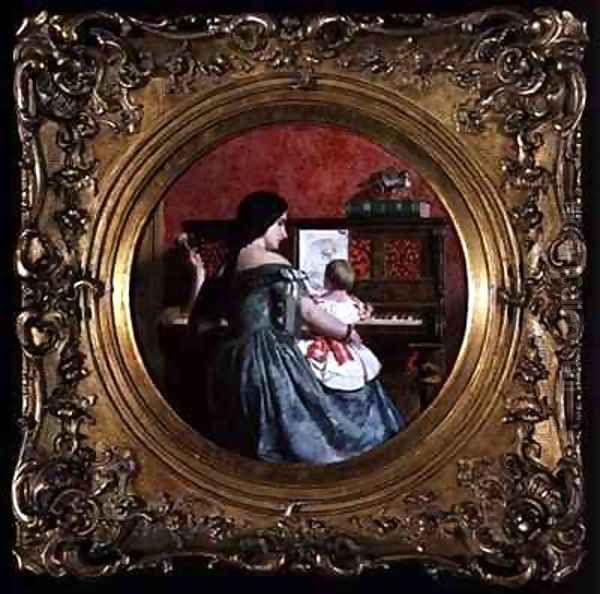
Cope himself produced numerous etchings throughout his career, often translating his own painted compositions into print or creating original designs. An example of his work in this medium is the etching Miss Riego de la Branchardiere. Another known etching was based on his painting A Fisherman's Goodnight. His involvement with The Etching Club highlights his commitment to artistic exploration across different media and his engagement with fellow artists in promoting specific aesthetic goals. His printmaking activities complemented his painting career, allowing for wider dissemination of his imagery.
Artistic Style and Influences
Charles West Cope's artistic style evolved throughout his long career but consistently displayed certain core characteristics. His early training and studies of the Old Masters provided a solid foundation in drawing, composition, and the handling of paint. The influence of the Venetian School, particularly artists like Titian, can be seen in his rich colour harmonies and balanced compositions. The psychological depth and use of light and shadow found in Rembrandt's work also informed Cope's approach, especially in his more dramatic or emotionally charged scenes.
His paintings are often characterized by an elegant sense of design and a careful attention to detail, whether depicting the textures of fabric in a domestic interior or the historical accuracy of costume in a parliamentary scene. He possessed a talent for conveying emotion in a realistic yet refined manner, avoiding excessive melodrama while still capturing the tenderness, anxiety, or solemnity appropriate to the subject. His colour palette is frequently described as pleasing or "sweet," contributing to the often gentle and accessible mood of his genre paintings.
While primarily known for figure painting, elements in his work occasionally show an awareness of other traditions, such as the careful arrangement and rendering of objects that might recall Dutch still life painting, integrated into his larger narrative scenes. Overall, Cope's style represented a successful blend of academic tradition and Victorian sensibility, resulting in works that were both technically accomplished and emotionally engaging for his contemporary audience.
Collaborations and Contemporaries
As an active member of the London art world and a Royal Academician (elected Associate in 1843 and full Academician in 1848), Charles West Cope inevitably interacted and sometimes collaborated with numerous contemporaries. His participation in the Royal Academy exhibitions placed his work alongside that of the leading artists of the day, fostering both comparison and collegiality.
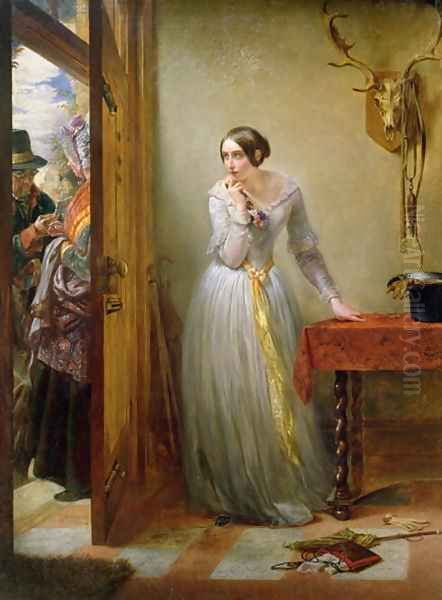
A specific instance of collaboration is documented in the work Timothy Frere sketching at the Royal Academy Exhibition, 1837, which Cope reportedly painted jointly with Timothy Frere, depicting a fellow artist at work within the exhibition space itself. This provides a glimpse into the interactive nature of the artistic community. His founding role in The Etching Club also signifies a direct collaborative impulse, working alongside artists like William Holman Hunt and Samuel Palmer towards shared artistic goals.
Beyond these specific instances, Cope worked within a vibrant artistic milieu that included painters with diverse specialisms. He would have known and exhibited alongside renowned figures such as Sir Edwin Landseer, famous for his animal paintings; William Powell Frith, the great chronicler of modern Victorian life in panoramic scenes like Derby Day; Daniel Maclise, his fellow contributor to the Houses of Parliament frescoes; Augustus Egg, known for his narrative paintings often exploring moral themes; and John Phillip, celebrated for his colourful depictions of Spanish life. While the Pre-Raphaelite Brotherhood, including figures like John Everett Millais, emerged during Cope's career with a radically different aesthetic, Cope remained largely aligned with the more established academic tradition, though his work shared the Victorian era's interest in narrative and sentiment.
Later Life and Legacy
Charles West Cope remained an active artist for much of his life. He had married Charlotte Benning in 1840, and the couple raised a family, providing perhaps personal inspiration for his many depictions of domestic harmony and parental affection. He continued to paint and exhibit, maintaining his position within the Royal Academy and the broader British art scene. He eventually retired to Bournemouth on the south coast of England, where he passed away in 1890 at the age of 79.
His legacy is multifaceted. Cope is remembered primarily as a quintessential Victorian painter, adept at capturing the ideals and sentiments of his age, particularly concerning family and home. His domestic scenes, like The First Piano Lesson, remain appealing for their charm and technical finesse. His significant contributions to the historical decoration of the Houses of Parliament ensure his place in the story of British public art, reflecting the nationalistic and historical consciousness of the 19th century.
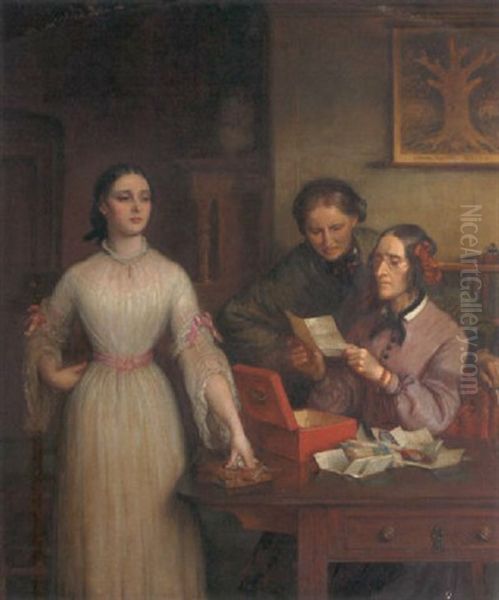
Furthermore, his role in founding The Etching Club and his own work as an etcher mark his contribution to the revival of printmaking as a fine art form in Britain. Works by Charles West Cope are held in important public collections, including the Royal Collection, the Victoria and Albert Museum, the Tate, and the Royal Academy itself, attesting to his historical significance. While perhaps not as revolutionary as some of his contemporaries, Cope's consistent quality, thematic range, and sensitive portrayal of human relationships secure his enduring reputation as a key figure in 19th-century British art. His work continues to offer valuable insights into the visual culture and social values of the Victorian era.
Conclusion
Charles West Cope navigated the Victorian art world with considerable success, establishing himself as a respected painter of both intimate domesticity and grand historical moments. From the tender portrayals of motherhood that resonated with private sentiment to the stately frescoes adorning the halls of power, his work captured key facets of 19th-century British life and identity. Grounded in academic tradition yet responsive to contemporary tastes, Cope combined technical skill with emotional sensitivity. His contributions to painting and etching, alongside his role within institutions like the Royal Academy and The Etching Club, solidify his position as an important and characteristic artist of his time, leaving behind a body of work that continues to illuminate the values and aesthetics of the Victorian age.